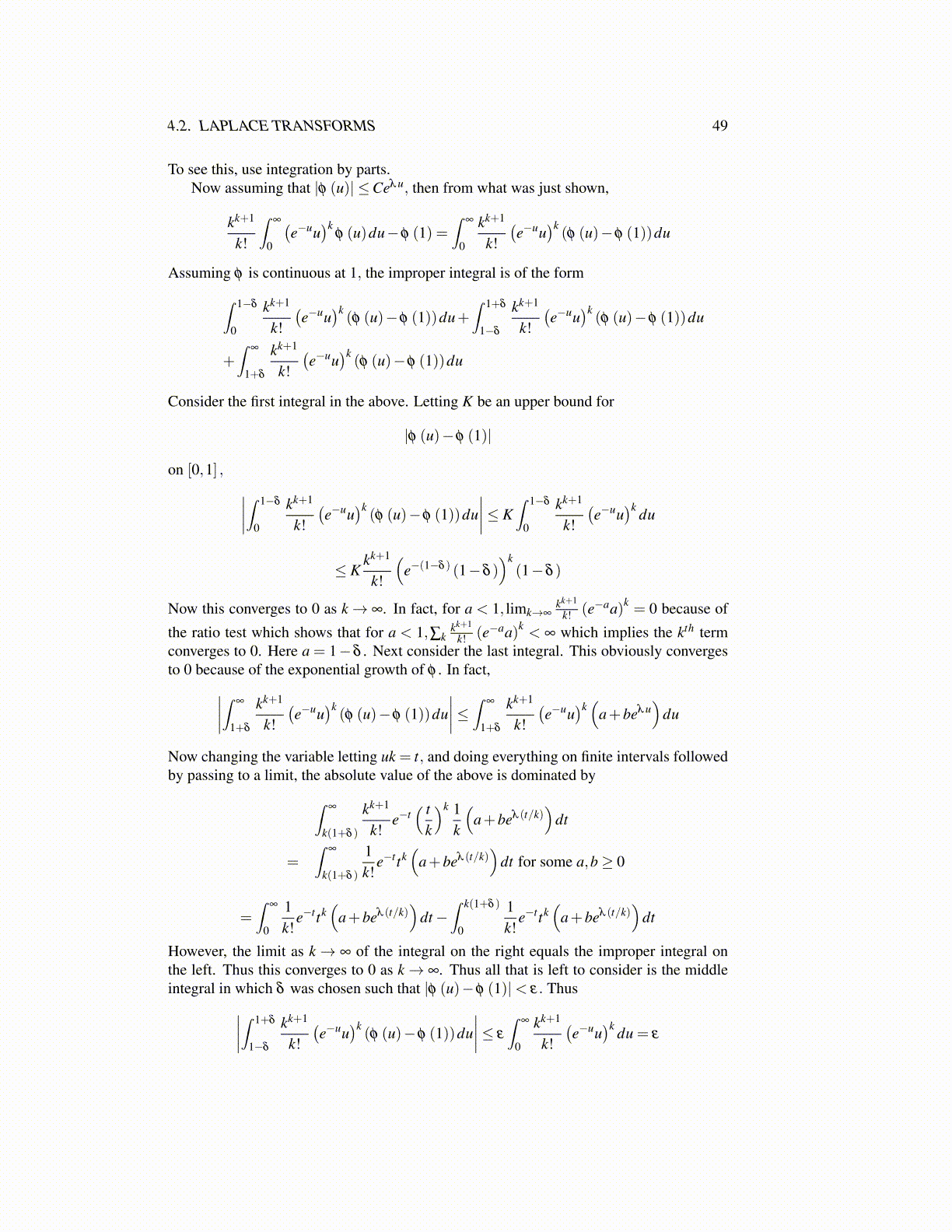
4.2. LAPLACE TRANSFORMS 49
To see this, use integration by parts.Now assuming that |φ (u)| ≤Ceλu, then from what was just shown,
kk+1
k!
∫∞
0
(e−uu
)kφ (u)du−φ (1) =
∫∞
0
kk+1
k!(e−uu
)k(φ (u)−φ (1))du
Assuming φ is continuous at 1, the improper integral is of the form∫ 1−δ
0
kk+1
k!(e−uu
)k(φ (u)−φ (1))du+
∫ 1+δ
1−δ
kk+1
k!(e−uu
)k(φ (u)−φ (1))du
+∫
∞
1+δ
kk+1
k!(e−uu
)k(φ (u)−φ (1))du
Consider the first integral in the above. Letting K be an upper bound for
|φ (u)−φ (1)|
on [0,1] , ∣∣∣∣∫ 1−δ
0
kk+1
k!(e−uu
)k(φ (u)−φ (1))du
∣∣∣∣≤ K∫ 1−δ
0
kk+1
k!(e−uu
)k du
≤ Kkk+1
k!
(e−(1−δ ) (1−δ )
)k(1−δ )
Now this converges to 0 as k→ ∞. In fact, for a < 1, limk→∞kk+1
k! (e−aa)k= 0 because of
the ratio test which shows that for a < 1,∑kkk+1
k! (e−aa)k< ∞ which implies the kth term
converges to 0. Here a = 1−δ . Next consider the last integral. This obviously convergesto 0 because of the exponential growth of φ . In fact,∣∣∣∣∫ ∞
1+δ
kk+1
k!(e−uu
)k(φ (u)−φ (1))du
∣∣∣∣≤ ∫ ∞
1+δ
kk+1
k!(e−uu
)k(
a+beλu)
du
Now changing the variable letting uk = t, and doing everything on finite intervals followedby passing to a limit, the absolute value of the above is dominated by∫
∞
k(1+δ )
kk+1
k!e−t( t
k
)k 1k
(a+beλ (t/k)
)dt
=∫
∞
k(1+δ )
1k!
e−ttk(
a+beλ (t/k))
dt for some a,b≥ 0
=∫
∞
0
1k!
e−ttk(
a+beλ (t/k))
dt−∫ k(1+δ )
0
1k!
e−ttk(
a+beλ (t/k))
dt
However, the limit as k→ ∞ of the integral on the right equals the improper integral onthe left. Thus this converges to 0 as k→ ∞. Thus all that is left to consider is the middleintegral in which δ was chosen such that |φ (u)−φ (1)|< ε. Thus∣∣∣∣∫ 1+δ
1−δ
kk+1
k!(e−uu
)k(φ (u)−φ (1))du
∣∣∣∣≤ ε
∫∞
0
kk+1
k!(e−uu
)k du = ε